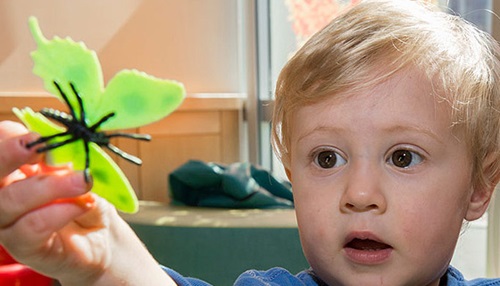Are Essential Oils Safe for Children?
Featured Expert
Pediatrician Rachel Dawkins, M.D., from Johns Hopkins All Children’s, gives expert advice on using essential oils on children.
What are Essential Oils?
Essential oils are concentrated extracts from the flowers, leaves, seed, bark, roots or peel of a plant. Since many companies are selling synthetic fragrances marketed as essential oils, it’s first important to understand where essential oils come from and what to look for when you purchase oils. It’s also important to understand the ongoing research around essential oils, advises Dawkins. “Remember that essential oils sold are not regulated by the Food and Drug Administration and safety studies are limited,” Dawkins says.
When purchasing essential oils, make sure the label lists the following:
- Name of the plant (for example, lavender)
- Latin name of the plant (such as Lavandula angustifolia)
- The part of the plant used to make the oil (leaf, flower, seed, bark or root)
- Country of origin
- How the oil was extracted (for example, steam distilled or expressed)
Do’s and Don’ts When Using Essential Oils on Children
Children are more likely to have adverse reactions to essential oils than adults, so it is important to know how to use them safely. “Concentrated oils are highly potent and can be risky if not used on children correctly,” Gujral says.
It is important to use essential oils intelligently. The following is a list of do’s and don’ts to remember:
- Don’t use undiluted oils directly on skin. Oils in their full form can be harmful if applied directly to the skin. Safe dilutions for children generally range from 0.5-2.5% depending on the condition and the age/weight of the child. Oils can be added to carrier oils, distilled water and lotions.
- Don’t add undiluted oils to bath water. Since oil and water don’t mix, the concentrated form could irritate the skin.
- Don’t swallow oils. Essential oils are highly concentrated oils that can be toxic if swallowed.
- Don’t overuse oils. Be mindful of how often and how much you use on your child. For example, don’t use a lotion that contains lavender and then apply an essential oil.
- Don’t use peppermint oil on children less than 30 months old. Peppermint used on children under 30 months of age can increase a risk for seizures.
- Don’t use oils near a heat source. Using essential oils near heat source can cause a fire.
- Don’t use essential oils near the eyes, ears and nose.
- Do buy oils from a reliable source. “Check the source of the essential oils to avoid oils that might contain contaminants,” Gujral says. “Look for credible companies that list the scientific name of the oil, source of the oil and who also list a contact number to answer any questions you might have.”
- Do avoid sunlight for some essential oils. Always check the caution remarks for each essential oil you use.
- Do store oils in a cool dry place. Store oils in a cool dry place away from direct sunlight and out of reach of children.
- Do apply a patch test first. Before using an oil on your child’s skin, apply on a small area of skin and wait 24 hours to see if there is an adverse reaction before using again.
- Do consult an expert. If you have any questions about how to use an oil or the dilution ratios to use on your child, consult an expert before use.
Essential Oils for Treating Symptoms
Some clinical studies show that essential oils can alleviate a variety of symptoms, as well as lift the mood. Before using essential oils on your child, however, discuss with your child’s primary care physician to ensure the essential oils you are using do not interact with your child’s medications. “Some kids have experienced allergic reactions, respiratory symptoms such as coughing and wheezing and burns from essential oils,” Dawkins says. “They can also interfere with medications.”
Dawkins adds, “Studies have shown certain essential oils to have anti-inflammatory and disinfecting properties and some oils can reduce symptoms such as nausea and vomiting related to surgery or chemotherapy.”
Symptoms include:
- Anxiety. Lavender, chamomile, basil and Frankincense can help with anxiety. Sweet orange can help with uplifting.
- Nausea and fatigue. Peppermint (for children over 30 months old), ginger and mandarin can help ease nausea symptoms.
- Headaches. Peppermint can help with headaches for children over 30 months old.
- Insect repellent. Basil oil has been known to help repel insects. Citronella is an insecticide. Avoid using it on children younger than 6 months.
- Insomnia. Lavender can help.
Safest Methods to Apply Essential Oils
Essential oils can be applied on the skin, inhaled or diffused. Gujral suggests using essential oils on the skin or inhaling them using an aromastick. “If using a diffuser, be mindful of others around you to make sure you are not putting others at risk. Also avoid using them in public spaces.”
Apply to skin. Apply diluted oils to child’s skin. Use a carrier oil to dilute the oil before applying to the skin. Dosage is the most important factor when it comes to safety. Know the correct dosage of each oil before applying to your child’s skin. Some guidelines from Essential Oil Safety, second edition:
- 3 months-24 months: 0.25% to 0.5%
- 2-6 years: 1% to 2%
- 6-15 years: 1.5% to 3%
- Over 15 years of age: 2.5% to 5%
Inhale through an aromastick. An aromastick is also known as an essential oil inhaler. Inhaling through an aromastick only benefits the user and does not affect others in the room, though it requires cooperation from the child.
If your child develops a skin rash or skin irritation, headaches, vomiting, coughing, wheezing or difficulty breathing, call your doctor. Never use essential oils to replace medical care.
Johns Hopkins All Children's General Pediatrics

The Johns Hopkins All Children’s General Pediatric clinics in St. Petersburg and Sarasota, Florida, provide primary care services that focus on the treatment and prevention of common conditions for children from newborns to adolescents. We offer a wide range of outpatient services, including routine checkups, treatment of minor illnesses, immunizations and care for behavioral problems.





